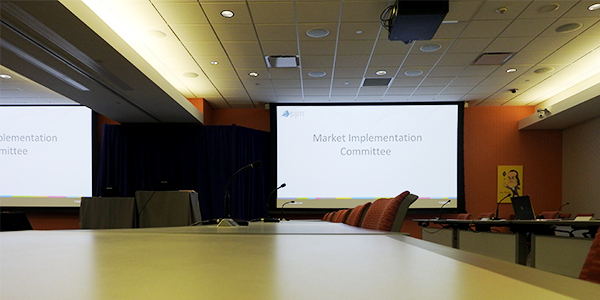VALLEY FORGE, Pa. — The 90-day clock for stakeholders to work out how PJM will unwind $100 million worth of financial transmission rights (FTR) settlements begins June 19, said PJM legal counsel Jen Tribulski.
The update comes after FERC issued an order June 5 that encouraged conflicting parties to hammer out disagreements ahead of a scheduled paper hearing under the guidance of a settlement judge, who will report progress on the discussions to the commission at the 45- and 90-day marks (ER18–2068). A one-time extension may be granted for 30 days, FERC said. (See FERC: PJM Settle Disputes Before GreenHat Hearing.)
The order also granted PJM’s motion for clarification on its denied petition to waive its liquidation rules, which has complicated the RTO’s efforts to minimize the damage of the default and potentially increases costs to members by $300 million. (See FERC Orders PJM to Unwind GreenHat Settlements and PJM: FERC Order Could Boost GreenHat Default by $300M.)
“During the settlement proceedings, all issues are on the table,” Tribulski said. “It doesn’t have to be just the six [issues PJM raised in its request for clarification]. If we go to hearing, it’s limited to just the six issues.”
Stakeholders expressed a mix of confusion and frustration over the ruling, with most unsure of what’s left to settle considering many were in agreement with PJM’s initial waiver request.
“The real problem is FERC just making the wrong decision and setting us down a path that PJM said is untenable,” said Carl Johnson, of the PJM Public Power Coalition. “You asked them to clarify their own rules, so I think it’s unrewarding that FERC is going to ask us to fix it among ourselves.”
5-Minute Dispatch Problem Statement Endorsed
Stakeholders gave near-unanimous support for the Independent Market Monitor’s problem statement to review processes for real-time security-constrained economic dispatch (RT SCED) and market pricing that PJM uses to send dispatch signals to generators and calculate LMPs. (See “Monitor Presents Updated 5-Minute Dispatch Problem Statement” in PJM MIC Briefs: May 15, 2019.)
Siva Josyula of Monitoring Analytics said a publishing price delay on April 8 — as well as a July 10, 2018, low area control error (ACE) event and corresponding Manual 11 revisions — call into question the transparency of PJM’s RT SCED processes.
Education about RT SCED will begin in the MIC next month.
Electric Storage Participation Rule Changes
PJM presented more manual revisions for electric storage participation rules in compliance with FERC Order 841.
In Manual 11: Energy & Ancillary Service Operations, section 2.3.4B was added to explain how electric storage resources (ESRs) would participate in the markets, including clarification that the resources can sell in the energy, capacity and ancillary markets if they are technically capable of providing those services. It also provides information on dispatch and pricing, bid parameters and clarifies that stored MWh are billed at LMP as wholesale. Staff also added definitions for defined modes and the opt-in and opt-out processes and updated ESR hourly limits.
In Manual 18: PJM Capacity Market, staff updated the definition of capacity storage resource to include ESRs that participate in the reliability pricing model or are “elsewhere treated as capacity in PJM’s markets such as through a fixed resource requirement capacity plan.” Revisions also clarify that ESRs may not receive peak load contributions for energy they sell back to the grid.
Laura Walter, a senior lead economist for PJM, said the purpose of the revisions — and many more anticipated in other manuals — is to open up markets for ESRs and ensure parameters allow such resources to operate effectively.
PJM’s ESRs include approximately 5,000 MW of pumped hydro and 310 MW of battery storage, she said. The resources will be allowed to offer into both the day-ahead and real-time markets and will be modeled as continuous resources with the ability to self-manage their own state of charge.
PJM will seek MIC endorsement at the July 10 meeting.
– Christen Smith





